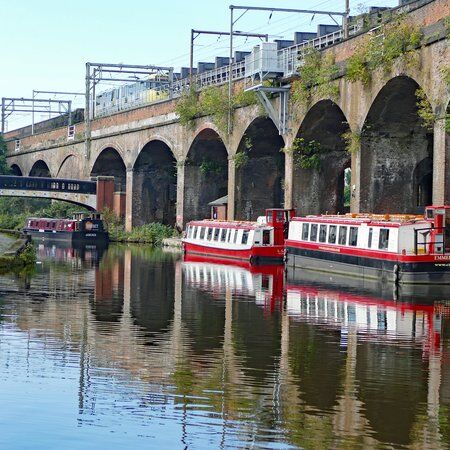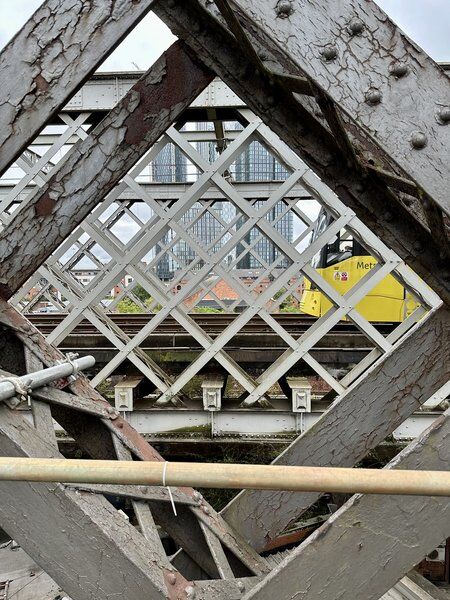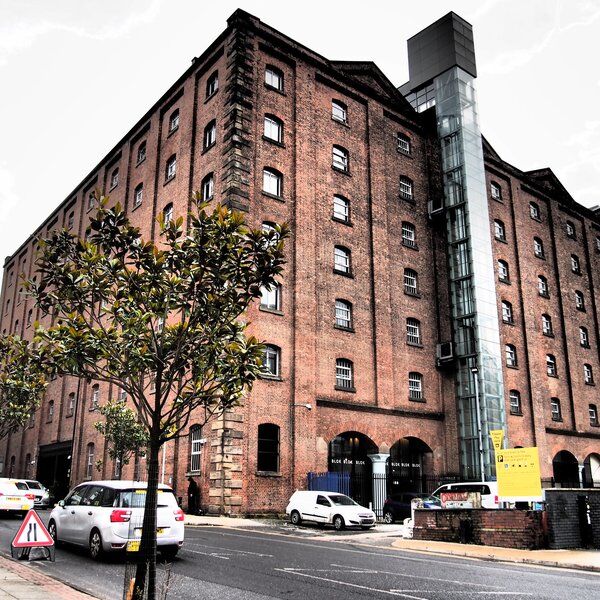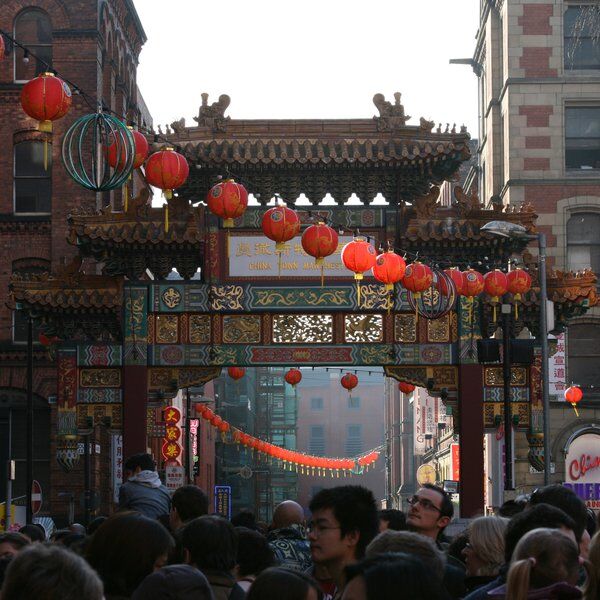Discover Castlefield Viaduct
The Castlefield Viaduct was once a means of transportation for Manchester’s imports and exports. However, after 77 years of abandonment the historic, steel viaduct was recently transformed into an elevated urban park, mirroring the popular New York High Line. In a collaboration between National Highways and the National Trust the ‘Sky Park’, as it is referred, was launched in the summer of 2023 as a temporary fixture. But fast forward one year and the garden has quickly become a beloved attraction for locals, Greater Manchester residents, and tourists.

Castlefield Viaduct History
Roman Beginnings
Castlefield, the oldest part of Manchester, dates back to AD 79 when Roman soldiers led by General Agricola established a timber fort named Mamucium. Positioned strategically by the Rivers Irwell and Medlock, it guarded important routes to larger Roman forts at York, Chester, and Ribchester. Over time, the fort was rebuilt in stone, and a nearby village (vicus) developed to support it. However, after the Romans left around AD 410, both the fort and the village declined and were eventually abandoned.
The World’s First Industrial City
By 1086, a village called 'Mamcester', was recorded in the Domesday Book. This village grew and incorporated the site of the fort, now known as Castlefield, becoming a town in the early 13th century. The area gained prominence in the late 18th century as Manchester entered its industrial era.
Manchester’s industrial journey began in 1758 when the Duke of Bridgewater commissioned James Brindley to build one of Britain’s first canals, along which coal was imported. The Bridgewater Canal's success led to canal construction nationwide. By 1804, the Rochdale Canal joined the Bridgewater Canal at Castlefield, transforming the area into a crucial canal trading hub.
A Hub for Transporting Goods
Manchester was quickly becoming the world’s fastest-growing city and needed a more efficient means of transporting goods—introducing the railway era. In 1830, Castlefield became home to the world’s first inter-city passenger railway station, Manchester Liverpool Road.
Over the next few decades, warehouses, including the Great Northern Warehouse built in 1855, sprung up to support this network. In 1891, construction began on the Castlefield Viaduct to carry railway lines to the warehouse and Central Station.
The Castlefield Viaduct
The viaduct was constructed in 1892 by Heenan and Froude, the engineers behind Blackpool Tower. It was hailed "a triumph of engineering skill" and cost a total of £250,000. For 77 years, the viaduct facilitated heavy rail traffic until it closed in 1969. For decades, the viaduct was maintained by National Highways as part of the Historical Railways Estate, but it remained unused. Although it did star in several TV series like Coronation Street and Peaky Blinders, and inspired the 'Motostoke' area in the Pokemon Sword/Shield games.

Transforming the Castlefield Viaduct
It wasn’t until June 2021 that the National Trust revealed their intention to transform the unused viaduct into a ‘Sky Park’, with the design expertise of Twelve Architects. The project, costing £1.8 million, was funded by Postcode Earth Trust and public donations, covering two-thirds of the build costs. It was designed to benefit the local community, especially the 50,000 residents within walking distance, many of whom belong to economically disadvantaged groups.
The primary challenge in the viaduct's transformation was to convert its hard, metal structure into a welcoming green space. And yet that is exactly what was achieved. Today this Grade II listed structure and new green space it encompasses has become a beloved public park in the city, for locals and tourists.

Inside the Castlefield Viaduct
Garden Areas
“The gardens are buzzing with bees and butterflies enjoying the plentiful nectar provided by the wildflowers and buddleias on the wilder parts of the viaduct.”
The viaduct’s garden is divided into three areas. The Welcome Area showcases native and National Trust-curated garden plants and also has a piece of ‘living wall’ that reveals the viaduct in its original, untouched state.
Moving forward, the Secret Garden contains modular planters made of red Corten steel, in honour of Manchester’s iconic red brick buildings. This area of the garden also has dense foliage and seasonal planting, including exotic species like pineapple flowers. It is a natural contrast to the remaining industrial elements of the viaduct.
Finally, an indoor events space, enveloped in greenery, offers views of the untouched west end of the viaduct. It acts as a window into the past; how the viaduct looked before the transformation.

‘Partner Plots’
The National Trust has partnered with local organisations to create unique ‘Partner Plots’, each reflecting different aspects of Manchester’s heritage and environment. These include:
- Sow The City: A sensory garden with a pond and bee-friendly plants to foster a connection with nature.
- City of Trees: Highlighting trees crucial to industrial development and climate change response.
- Castlefield Forum: Showcasing the area’s history and culture in a modern garden design.
- Hulme Community Garden Centre: Presenting an urban forest garden that promotes layered planting for environmental and personal wellbeing.
Sustainability in the Garden
Over 80% of the materials used are designed for reuse, and efforts were made to minimise operational waste and carbon emissions. The park includes energy-efficient features like LED lighting and rainwater harvesting. Accessibility by foot, bicycle, and public transport further reduces the carbon footprint of visitors.

What is the Future of the Castlefield Viaduct in Manchester?
Extending the ‘Sky Park’ Project
“We’re delighted to be staying open for another year so we can continue to provide visitors with moments of joy and build momentum to create a future for this fantastic place.”
The National Trust operates the park on a 12-month trial. Since its opening, the viaduct received an overwhelmingly positive response, with high demand for visiting slots. As a result, in July 2023, the project was granted an extension, remaining open to visitors until autumn 2024. This extension, granted by Manchester City Council, has allowed the National Trust to continue its transformation of the viaduct.
Future Plans
The current goal is to extend the ‘Sky Park’ further west. As the project progresses into its next phase, the National Trust, in collaboration with the newly appointed landscape architects BDP, will seek further funding to achieve this goal.
It is also essential for the National Trust to gather visitor feedback on the viaduct. The covered ‘ideas and events’ space on the viaduct invites visitors to contribute their thoughts and participate in various creative and educational activities. This engagement is crucial as the National Trust and its partners work towards making the viaduct a permanent feature of Manchester’s urban landscape.

Visiting Castlefield Viaduct
Opening Times and Guided Tours
Castlefield Viaduct can be freely visited by walking-up on the day or by booking a guided tour in advance. Guided tours are available from 10:30 am to 12:30 pm on Mondays, Tuesdays, Thursdays, and Fridays. These tours require pre-booking, which can be done online for free. After 12:30 pm on these days, as well as all day on Wednesdays, Saturdays, and Sundays, the viaduct is open for self-guided exploration. Entry is based on capacity as only 100 visitors are permitted to visit the viaduct each day.
Facilities at the Viaduct
The main viaduct route is level and features smooth bonded gravel, though there is a slight incline into the visitor building. The viaduct is equipped with two accessible toilets, including facilities for baby changing. For those requiring additional assistance, two wheelchairs are available for loan. The site has static induction loops at the welcome area and visitor building, with personal loops available for guided tours. The viaduct welcomes only assistance dogs. And although there are no food or drink facilities on-site, there are several options nearby.

Upcoming Events
The National Trust and local organisations regularly host events at Castlefield Viaduct. These events include gardening workshops, family trails, cultural performances, and talks such as the Wednesday At One Talks and Sundowners series. These events offer visitors an opportunity to learn more about the viaduct's history and participate in the ongoing evolution of this unique community space. Perhaps it will remain open longer!
Getting to Castlefield Viaduct
There are several ways to get to the viaduct:
- By Road: There is no dedicated parking at the viaduct. Visitors are encouraged to use public transport. Various city centre car parks are available nearby.
- On Foot: From Deansgate-Castlefield tram stop, cross the tram lines, turn left down the access road, and follow signs to the viaduct. If approaching from Liverpool Road, climb the staircase near Duke Street.
- By Train: Arrive at Deansgate train station, cross the bridge to Deansgate-Castlefield tram stop, and follow the access road to the viaduct entrance.
- By Bus: Alight at Deansgate-Castlefield tram stop, cross the tram lines, turn left down the access road, and follow signs to the viaduct.
- By Bicycle: While cycling is not permitted on the viaduct itself, visitors are welcome to bike to the site. Use the access road from Albion Street and park at the designated bike racks.
- Metrolink Tram: Alight at Deansgate-Castlefield tram stop, cross the tram lines, turn left down the access road, and follow the signs to the viaduct entrance.

Discover Nearby Attractions in Manchester with CityDays
If you want to discover the Castlefield Viaduct and other aspects of Roman Manchester in a more comprehensive way—with rest stops at cafes and bars along the way—why not embark on a Manchester Treasure Hunt?
Our Through the Ages hunt in particular takes visitors on a puzzle-filled exploration through Castlefield, along Manchester's industrial canals, and into the grand city centre.
Treasure Hunt tours are a great way to bring family and friends—or even dates—together for an afternoon of great fun and adventure, solving clues and snapping photos. Clues will lead you to the big sights and those that you'd walk straight past.
For more information about our Manchester Scavenger Hunts then click here: Manchester Treasure & Scavenger Hunts | CityDays.
















